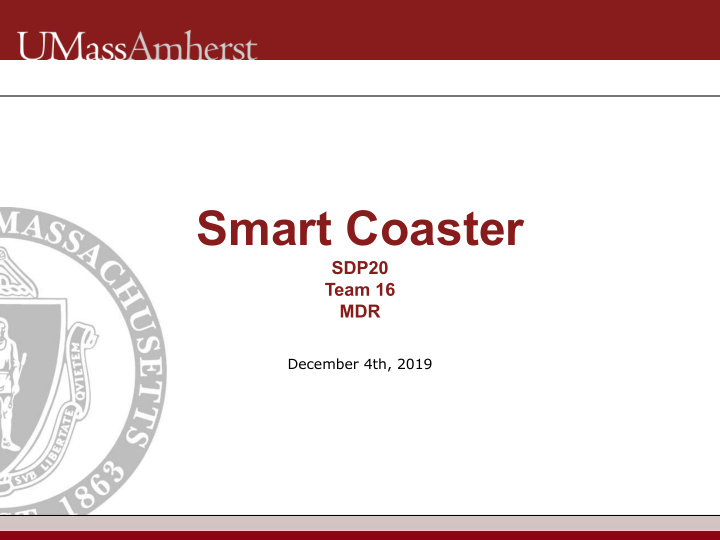



Smart Coaster SDP20 Team 16 MDR December 4th, 2019
Meet the Team Professor Joshua Jonathan Capozzi Timothy Shum Angus Mo Joshua Howell Yang EE EE EE CSE Advisor 2
Problem Statement At restaurants, fast and responsive service leads to higher customer satisfaction. Waiters/waitresses often juggle serving several tables at the same time. A customer might finish their drink and have to wait a while for service. 3
Specifications ● >95% “empty glass” detection rate ● <1% “empty glass” false positives ● >12hr battery life ● <5hr recharge time ● <2cm coaster thickness ● Supports multiple coasters ● Accurately detects a new/refilled beverage ● Accurately determines weight of glass itself ● Accounts for ice or other leftovers ● Reach Goal: Wireless charging station 4
Block Diagram - Software Requirements ● Determine expected empty and full weights Each range is bounded by the empty weight and ○ max full weight Relate weight ranges to container types ○ Standard glass, coffee mug, wine glass, etc. ○ ● Detect empty drinks with ice/other leftovers Log the time when the weight last changed by ○ more than some threshold Track how long a drink has gone untouched ○ ● Notify staff Alert waiters/waitresses when drink is low/empty ○ Hub notifies app to send alerts ○ 5
Block Diagram 6
MDR Block Diagram 7
Power Plan Battery Choice: Each coaster will have two 3.7V 2600mAH Li-Ion rechargeable ● batteries in series. This 7.4V supply voltage will be stepped down to the 5V operating ● voltage chosen. If we were to bring down the operating voltage of our Amplifier ● we could potentially use a series of nickel metal hydride (NiMH) batteries. Subject to change based on the current needs of future part ● selection such as the microcontroller. 8
Power Plan Charging: Recharge station on the central hub ● (Regulated power supply using the same wall supply the hub is connected to) The coasters are rechargeable ● through the same process as restaurant pagers - Metal Contacts on the screws that hold the enclosure together - The charge travels up through all the coasters that are stacked, charging them all simultaneously - Metal plates make contact with the screws internally to charge the batteries 9
Load Cell ▪ High accuracy ▪ Highly linear ▪ Small output voltage ▪ Needs an amplifier so that we can use the range of our ADC 10
Instrumentation Amplifier ▪ Needed to bring the output voltage range of the load cell to the range of the ADC ▪ ~ .4mV-3.7mV from the load cell ▪ Picked a gain resistor to reach for 1000 V/V gain ▪ Operating at a supply voltage of 5V 11
ADC and Measurement Precision ▪ ATMEGA328 ADC maps analog input between 0-5V to a digital range 0-1023 ▪ Each ADC value represented roughly by 5mV ▪ Considering noise ~ 7.5mV amplitude, expected +/- 1.5 error in ADC value ▪ Depending on calibration, accuracy of about X grams/ADC value 12
Wireless Communication Requirements: Nordic Semiconductor's nRF24L01+ is a common ▪ Send status notification 2.4GHz radio transceiver IC for wirelessly to a central hub low power/bandwidth scenarios. ▪ Does not have to be ▪ 1.9V-3.6V real-time, i.e. report status Transmission: ~12mA • every few seconds Standby: 26µA • ▪ Low power communication Power down: 0.9µA • ▪ Working range up to 100m in open space 13
MDR Deliverables Arduino-driven coaster and hub prototype ● Sensor Accuracy: Weight error <10 grams ○ Differentiate between drink levels ○ ● Coaster Functionality: Full, half-full, empty ○ ● System Communication: Hub receives and logs weight sent from coasters ○ 14
Gantt Chart 15
Responsibilities 16
Demo
References ▪ FSR Wiring https://www.electronicdesign.com/analog/signal-conditioning-force-sensing-resistors • ▪ Connecting FSR to AVR https://learn.adafruit.com/force-sensitive-resistor-fsr/using-an-fsr • ▪ MCU Wifi https://circuitdigest.com/microcontroller-projects/esp8266-nodemcu-with-atmega16-avr-microcontroller-to-s • end-an-email ▪ nRF24L01+ RF Transceiver IC https://lastminuteengineers.com/nrf24l01-arduino-wireless-communication/ • ▪ Force Sensing Resistor (FSR) https://www.adafruit.com/product/1075 • 18
Recommend
More recommend